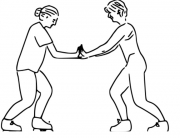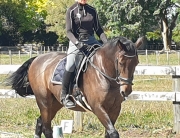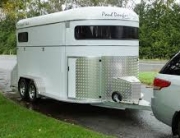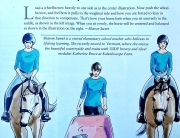The Reins and the Rider – Some problems that aren’t what they seem
A rider usually talks about a symptom of the problem, what’s happening and what they feel. When they try to fix the symptom they often cause other problems.
It’s easy to ride for an hour fixing the symptom when all you have done is made a band-aid to cover the real issue. Then, your horse is training you!
The way you think about what is going wrong determines the way you will go about fixing it.. When you address the underlying problem, you ride differently from when you are riding the symptom. Here are a few situations in which you the rider can fix the problem instead of the symptom.
A Horse that is Heavy in the Hand
Riding the symptom: By trying to make him light.
In getting the horse light or ( off the rein), you can create another problem, because self-carriage doesn’t come by getting your horse off the bit ,or behind the bit. He needs to be on the bit but in a positive way. You need to feel that the horse is taking you somewhere. Like you are holding hands and he is drawing you towards something.
The horse’s heaviness is a symptom . What is really happening is he is not accepting your aids but rather just running away from his hind legs because he doesn’t want to carry weight with them.. He’s behind the leg.
He will get lighter in front when he’s in front of your leg and accepting your half halts.
It’s difficult to use the leg when your horse is running, but you have to be able to activate the hind legs in a way that doesn’t dump the horse into your hand.
Do things that require the use of your leg, such as turn on the forehand, leg yield, shoulder-fore and lots of bending and turning lines. Sideways exercises require diagonal aids that give you leverage between the inside leg and outside rein. Your leg persistently asks your horse to draw positively on the bit. Your inside leg says, step under your center of gravity. Your outside rein says, wait for me. We can go more forward when you step up to the bit, drawing on the rein, not pulling. You want to feel that you can drive and ride from back to front, even while slowing down.
The half halt aids:
If you only stop the horse in front, he will stop behind too. When you sit against the rein for a half halt and the horse’s hind leg is engaged, he will transfer weight to the hindquarters. Your half halts, in this situation, close his frame from behind. Remember to release after the half halt so your horse has an opportunity to balance on your seat, and your hand is available for him to draw on but not lean on. Similarly don’t drop him. Make sure you feel like you are holding hands.
The importance of the rider’s position:
The rider’s position should shape the horse. When the horse is pulling and trying to balance on the rider’s hand, it is common for the rider to fall behind the vertical and let her legs go forward. To prevent this, the rider needs to keep a strong core, Neutral spine with the classic shoulder hip and ankle line. The feeling of pushing a heavy wheelbarrow through mud is a good way to think about this.
Exercises for the heavy horse
Trot-walk-trot transitions within the leg yield.
For a horse that is running and heavy in the hand, combine exercises that require him to step from your leg to your hand with exercises that require him to listen to your half halts.Trot-walk-trot transitions within lateral work.
For a Horse that is Heavy on the Left Rein
Riding the symptom: Because the rider’s discomfort is in the left hand, it’s easy to fixate on that rein alone.
The left rein heaviness is a symptom of the horse’s crookedness.
Focus on riding more to the empty right rein, until Your horse is equal in the contact. Then he will be more supple and bendable to the left. All horses prefer one rein over the other, and the problem doesn’t always manifest itself as heaviness in one rein. Some horses brace against one rein without being heavy. Some horses tilt their heads as evidence of their crooked tendencies. Focus on developing contact with the right rein and creating a supple, even connection.
Rider position:
When the rider stays soft on the hollow side and holds the left rein, it gives the horse something to balance on and perpetuates the problem. The left rein sometimes gets longer, the rider’s left leg slides forward and the left hip collapses. Remember your biomechanics, your body shapes his body, not the other way around.
For a horse heavy on the left rein, do the following exercise in both directions. It will be especially Start on a 20-meter circle in trot. On the open part of the circle, transition to walk and leg yield away from your inside leg. When you feel your horse connect to the outside rein, trot off and soften the inside rein.
The result: Your horse will become steady, solid but soft in the right rein. You will be able to track left and right with equal ease, putting him on one outside rein and then the other and it will be easier for him to be straight.
Do lots of direction changes smaller and larger circles . The circle exercise in blog no 2 is very helpful in getting the horse off his forehand and into your outside rein.






Follow Us!